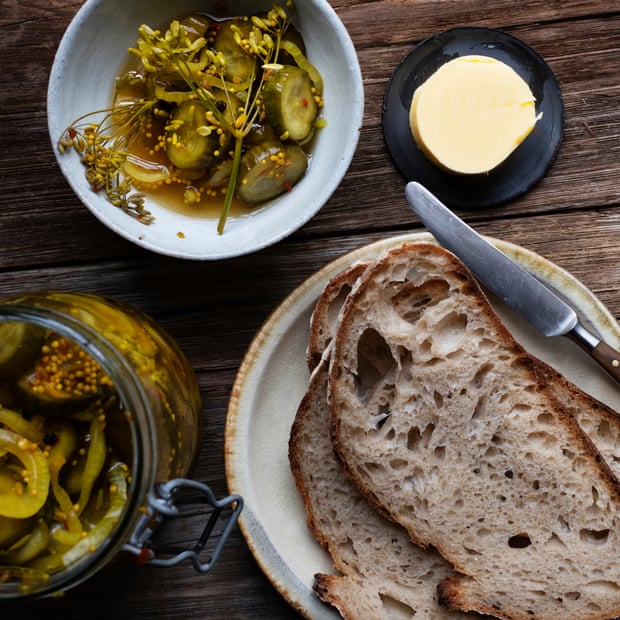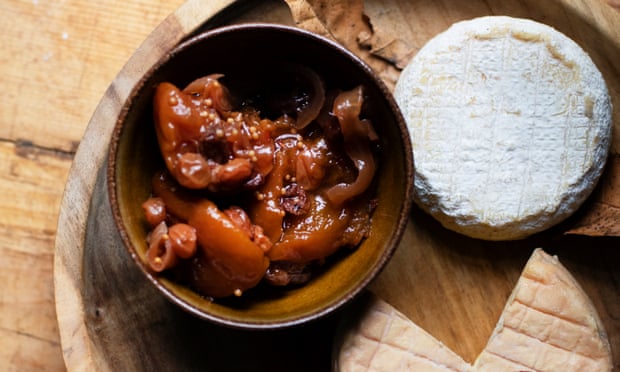
At this time of year, I put away damsons, gooseberries and blackcurrants in the freezer. A squirrel-store of fruits that are distinctly seasonal and are pretty much impossible to find in the freezer aisles. In the depths of winter, I rather enjoy an out-of-season gooseberry crumble or a hot damson compote with my breakfast porridge. But my freezer is small and soon filled.
When apricots have finally come down in price, I make jars of glowing jam; when peaches are at their best or the supply of courgettes and beetroot seems never-ending, I will make jam or chutney. If I find a cheap supply of those intensely flavoured tiny cucumbers that are so difficult to track down, they will end up in a homemade pickle with fennel seeds and dill to eat with cheese. A row of glistening jars to last me through the winter.
This summer I grew lavender and scented geraniums like never before (I can usually kill a lavender bush at 20 paces), so their flowers and leaves have ended up stored in jars of sugar to make a scented sprinkle for sponges or shortbread. Rose petals too.
I am not the sort of cook to make hundreds of pots of chutney or pickles, yet there is something rather delightful about opening a kitchen cupboard to find recycled jam jars full of your own handiwork. Recipes you have personalised to your own taste. A homemade pickle can be as sweet or sour as you like; jam can be more softly set than commercial recipes and the chilli heat of a relish can be tweaked to work for you.
There is, to a certain extent, a bit of good housekeeping going on here. When something is in such generous supply that it comes down in price I will make the most of it, picking up a few extra courgettes to make into a pickle or a second and third bag of plums with which to make jam. That said, I make all preserves as a treat rather than a way to rid myself of a cartload of fruit or vegetables. A jar or two of peach chutney or bread and butter pickles is like finding treasure in the cupboard, but I don’t want to be eating runner bean relish or marrow jam for the next six months.
You should use sterilised storage jars for all preserves and pickles. Heat the oven to 160C fan/gas mark 4. Remove the rubber seals from your storage jars, pour boiling water into the jars, carefully emptying them and leaving them to dry upside down on a baking sheet or roasting tin. Put the tray into the oven and bake for 15 minutes, then fill and seal as required.
Apricot and rose-petal jam
This is one of the few preserves I make every year. My version is softer than most you can buy, rather like the jams you find in the Middle East. Letting the stoned fruit rest overnight under a blanket of sugar is a trick worth following. The sugar softens the fruit, leading to a shorter cooking time and the flavour seems more intense. Use a sugar thermometer from the start. If you don’t have one, then chill a couple of saucers in the fridge before you start and follow the instructions here. This is luscious soft-set jam, but if you want something firmer use preserving sugar with added pectin. Make sure your roses are from the garden and unsprayed.
Makes 3 x 350ml storage jars
apricots 1kg, firm, almost ripe
granulated sugar 750g
rose petals 40
lemon 1, large
Wipe the apricots, remove any stems, then slice in half and remove their stones. Put the fruit in a large mixing bowl, then sprinkle the granulated sugar over them. Cut the lemon in half, squeeze the juice over the fruit, then toss everything together with a large spoon, so the sugar is wet with juice. Cover the bowl and set aside for three or four hours, or even overnight, in a cool place.
Put a large, heavy-based stainless-steel or enamel saucepan over a low to moderate heat. Add the fruit and sugar and bring to the boil. Lower the heat and leave to bubble gently for about 20 minutes. The jam is ready when it reaches 105C on a sugar thermometer. As soon as the temperature is reached, stir in the rose petals, ladle into sterilised jars and seal tightly.
To test without a thermometer, put a couple of saucers in the fridge. As the fruit becomes tender, put 1 teaspoon of jam on one of the cold saucers. Put it back in the fridge for 2 minutes and, if a skin has formed, the jam is ready.
Bread and butter pickles
I was tempted by the deliciously old-fashioned name alone, but I felt I had to have a go at making this sweet-sour pickle after I bought an artisan-made version whose price was more than I wanted to pay. Small cucumbers can be bought from Turkish and Middle Eastern grocery shops.
Makes 1 x 750ml storage jar and 1 smaller one
onions 250g, medium
small, crisp cucumbers 500g
salt 1½ tbsp
soft brown sugar 250g
malt vinegar 100ml
cider vinegar 300ml
ground turmeric 1 tsp
yellow mustard seeds 1 tbsp
black peppercorns 1 tsp
fennel seeds 2 tsp
dried chilli flakes ½ tsp
fennel stalks and flowers a handful (optional)
Peel the onions, slice them into thin rounds, then put them in a stainless steel or china bowl. Slice the cucumbers into rounds about 1cm thick, add them to the onions and sprinkle everything with the salt. Cover and leave for a good couple of hours, overnight it you have time.
Put the soft brown sugar, vinegars, ground turmeric yellow mustard seeds, peppercorns, fennel seeds, chili flakes and fennel stalks and flowers if you are using them into a large saucepan and bring to the boil.
Rinse the cucumber and onions in a colander under the cold tap to remove the salt. Pour the boiling pickling liquor over the vegetables in a bowl, then spoon into jars and seal.
Beetroot and carrot relish

It is something of a blurred line between relish and chutney and I’m not sure it makes much difference what you call them, but a general rule of thumb is that a chutney contains some sort of fruit (including dried vine fruits) and a relish is more vegetable based, somewhat finer in texture and is cooked for a shorter time.
This recipe is for those keen to rid themselves of some of their beetroot harvest. It has the mild, hot crunch of mustard seeds and is one that I bring out with a vegetable curry or spoon on to grilled lamb flatbread.
Makes a large jar, about 750ml
raw beetroot 325g
carrots 350g
ginger 50g
red chilli 1, medium hot
yellow mustard seeds 1 tsp
lemon 1
garlic 6 cloves
salt 1 tsp
black peppercorns 8
cider vinegar 200ml
soft brown sugar 175g
Peel and coarsely grate the beetroot, then put it in a medium sized stainless-steel or enamelled pan. Peel and coarsely grate the carrots, then add to the beetroot.
Peel the ginger, slice it thinly (about the thickness of a pound coin), then cut each slice into matchsticks. Add them to the beetroot and carrot, then thinly slice and add the chilli. (You can remove the seeds or not, as you wish – leave them in for a spicier relish.)
Mix in the mustard seeds, the zest of the lemon, finely grated, and the peeled, whole garlic cloves. Add a teaspoon of salt and the whole peppercorns. Halve and squeeze the lemon and add the juice to the pan together with the vinegar and sugar.
Bring to the boil over a moderate heat, stirring gently until the sugar has dissolved and all is glossy – then keep it bubbling until the liquid has almost disappeared. Pack into jars and seal. This is best kept in the fridge.
Peach chutney

A good chutney with a nice balance of vinegar-sharp fruit and deep sweetness that makes it a good one for cheeses such as caerphilly or properly made farmhouse cheddars. It is quite perfect for the firmer blues too.
Makes 1 x 750ml storage jar
peaches 1kg
onions 350g
golden raisins 125g
light muscovado sugar 250g
crushed dried chillies ½ tsp
yellow mustard seeds 2 tsp
cider vinegar 150ml
malt vinegar 150ml
cinnamon stick 1, broken in two
Quarter the peaches and discard the stones. If the fruit is large, cut each piece once more. Peel and roughly chop the onions.
Put the fruit and the onions into a large heavy bottomed steel or enamelled pan. Add the raisins, sugar, chillies, mustard seeds, vinegar and cinnamon stick. Bring the mixture to the boil, then reduce the heat to low. Simmer on low heat, stirring occasionally, for about 45 minutes. You want a chutney that is both sour and sweet to the taste, so tweak it to your taste, but it is worth remembering that the flavour will mellow as it keeps.
Pour into hot and sterilised jars and seal tightly.
Rose geranium and lavender sugars

These sugars are such a simple but effective way to use the many varieties of scented geranium (pelargonium) leaves or lavender buds. Make sure your leaves are dry and from a variety that smells only of rose or lemon when rubbed. (If the leaves don’t remind you of Turkish delight, then don’t use them.) The oils present in the leaves will gently scent your sugar over the following few weeks, leaving you with fragrant crystals to scatter over shortbread or almond cookies as they leave the oven, or over a sponge cake.
Makes a medium-sized jar
granulated or caster sugar 300g
scented geranium leaves 12, small, or lavender buds 2 tbsp
Make sure there are no lumps in the sugar and that your storage jars and leaves or flowers are completely dry. Layer the sugar and leaves in a storage jar, seal and keep in a dry, dark place for several days before opening and using.
If you are making lavender sugar, distribute the lavender buds through the sugar and seal. Sieve out the flowers before using. (If you use whole sprigs of lavender it is easier to remove than the picked flowers.)
Follow Nigel on Instagram @NigelSlater



